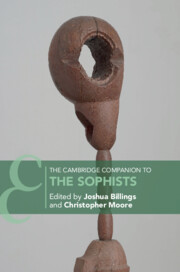139 results
Chapter 4 - Feminine Beginnings: Women’s Critical Perspectives on Debussy (1897–1914)
- from Part I - Paris: City, Politics, and Society
-
-
- Book:
- Debussy in Context
- Published online:
- 23 May 2024
- Print publication:
- 23 May 2024, pp 34-44
-
- Chapter
- Export citation
The predictive role of symptoms in COVID-19 diagnostic models: A longitudinal insight
-
- Journal:
- Epidemiology & Infection / Volume 152 / 2024
- Published online by Cambridge University Press:
- 22 January 2024, e37
-
- Article
-
- You have access
- Open access
- HTML
- Export citation
Part III - Receptions
-
- Book:
- The Cambridge Companion to the Sophists
- Published online:
- 23 December 2023
- Print publication:
- 19 October 2023, pp 335-437
-
- Chapter
- Export citation
Appendix: The People of the Sophistic Period
-
- Book:
- The Cambridge Companion to the Sophists
- Published online:
- 23 December 2023
- Print publication:
- 19 October 2023, pp 438-461
-
- Chapter
- Export citation
Copyright page
-
- Book:
- The Cambridge Companion to the Sophists
- Published online:
- 23 December 2023
- Print publication:
- 19 October 2023, pp iv-iv
-
- Chapter
- Export citation
Note on the Text
-
- Book:
- The Cambridge Companion to the Sophists
- Published online:
- 23 December 2023
- Print publication:
- 19 October 2023, pp x-x
-
- Chapter
- Export citation
Select Bibliography
-
- Book:
- The Cambridge Companion to the Sophists
- Published online:
- 23 December 2023
- Print publication:
- 19 October 2023, pp 462-497
-
- Chapter
- Export citation
Index
-
- Book:
- The Cambridge Companion to the Sophists
- Published online:
- 23 December 2023
- Print publication:
- 19 October 2023, pp 498-509
-
- Chapter
- Export citation

The Cambridge Companion to the Sophists
-
- Published online:
- 23 December 2023
- Print publication:
- 19 October 2023
Contributors
-
- Book:
- The Cambridge Companion to the Sophists
- Published online:
- 23 December 2023
- Print publication:
- 19 October 2023, pp vii-ix
-
- Chapter
- Export citation
Part I - Contexts
-
- Book:
- The Cambridge Companion to the Sophists
- Published online:
- 23 December 2023
- Print publication:
- 19 October 2023, pp 31-154
-
- Chapter
- Export citation
Introduction
-
-
- Book:
- The Cambridge Companion to the Sophists
- Published online:
- 23 December 2023
- Print publication:
- 19 October 2023, pp 1-30
-
- Chapter
- Export citation
12 - The Fourth-Century Creative Reception of the Sophists
- from Part III - Receptions
-
-
- Book:
- The Cambridge Companion to the Sophists
- Published online:
- 23 December 2023
- Print publication:
- 19 October 2023, pp 337-369
-
- Chapter
- Export citation
Contents
-
- Book:
- The Cambridge Companion to the Sophists
- Published online:
- 23 December 2023
- Print publication:
- 19 October 2023, pp v-vi
-
- Chapter
- Export citation
Part II - Thought
-
- Book:
- The Cambridge Companion to the Sophists
- Published online:
- 23 December 2023
- Print publication:
- 19 October 2023, pp 155-334
-
- Chapter
- Export citation
Inclusion of postdoctoral trainees in a translational science training TL1 program was associated with greater diversification of research across the translational science continuum: a bibliometric analysis of TL1 trainee publications
-
- Journal:
- Journal of Clinical and Translational Science / Volume 7 / Issue 1 / 2023
- Published online by Cambridge University Press:
- 28 July 2023, e173
-
- Article
-
- You have access
- Open access
- HTML
- Export citation
PRESOCRATIC TEXTS FROM HERCULANEUM - (C.) Vassallo The Presocratics at Herculaneum. A Study of Early Greek Philosophy in the Epicurean Tradition. (Studi Praesocratica 11.) Pp. xxii + 763. Berlin and Boston: De Gruyter, 2021. Cased, £118, €129.95, US$149.99. ISBN: 978-3-11-072698-5.
-
- Journal:
- The Classical Review / Volume 73 / Issue 2 / October 2023
- Published online by Cambridge University Press:
- 24 April 2023, pp. 419-420
- Print publication:
- October 2023
-
- Article
- Export citation
“Comprehensive Healthcare for America”: Using the Insights of Behavioral Economics to Transform the U. S. Healthcare System
-
- Journal:
- Journal of Law, Medicine & Ethics / Volume 51 / Issue 1 / Spring 2023
- Published online by Cambridge University Press:
- 25 May 2023, pp. 153-171
- Print publication:
- Spring 2023
-
- Article
-
- You have access
- Open access
- HTML
- Export citation
Comparison of bibliometrics for predoctoral Translational Science Training (TST) TL1 Program participants and nonparticipants, male and female participants, and participants from underrepresented and well-represented backgrounds
-
- Journal:
- Journal of Clinical and Translational Science / Volume 7 / Issue 1 / 2023
- Published online by Cambridge University Press:
- 01 December 2022, e12
-
- Article
-
- You have access
- Open access
- HTML
- Export citation
Limited impact of a nudge comment in promoting de-escalation to first-generation cephalosporins in urinary tract infections
-
- Journal:
- Antimicrobial Stewardship & Healthcare Epidemiology / Volume 2 / Issue 1 / 2022
- Published online by Cambridge University Press:
- 26 September 2022, e160
-
- Article
-
- You have access
- Open access
- HTML
- Export citation



